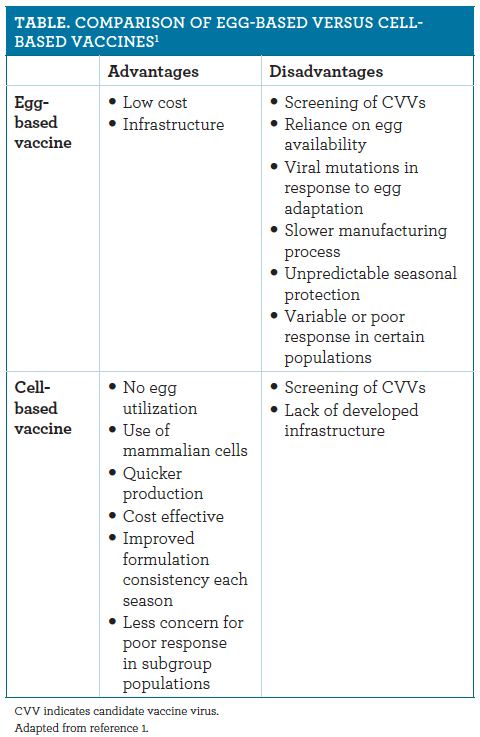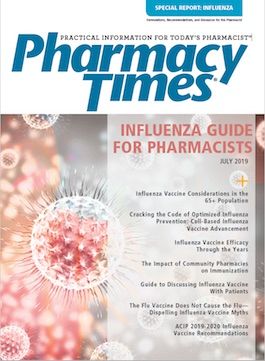Publication
Article
Supplements
Cracking the Code of Optimized Influenza Prevention: Cell-Based Influenza Vaccine Advancement
Author(s):
Cell-based vaccines have many potential advantages, one of which includes longer stability and more rapid manufacturing, as cellbased vaccines can be frozen and used at a later date, with dependable cell lines to ensure consistent supply.
A dvancing technology in vaccine development has allowed for the production of cell culture—based vaccines for illness such as chickenpox, rotavirus, polio, smallpox, hepatitis, rubella, and most recently influenza (flu). Cell-based vaccines have many potential advantages (see Table1), one of which includes longer stability and more rapid manufacturing, as cellbased vaccines can be frozen and used at a later date, with dependable cell lines to ensure consistent supply. Cell-grown, cell-based candidate vaccine viruses (CVVs) more similarly resemble circulating flu viruses; in contrast, egg-adapted alternatives may result in production of antibodies that less effectively prevent specific flu viruses.2 Additionally, cell-based vaccine formulations are preservative-free and present less concern for viral mutations caused by the egg-based vaccine production (which, in turn, can cause less effective immune responses to flu viruses). Avoidance of traditional manufacturing processes may also help reduce the risk of adverse reactions in patients with egg allergies.

Since the advent of increased legislation and funding in 2005, cell-based vaccine development has been a priority for US pandemic influenza preparedness.3 As a result, cell-based influenza vaccine development has rapidly advanced. Traditional egg-based vaccines face limitations such as a reliance on an adequate global egg supply, the inability to ramp up manufacturing quickly, a long production process, and the potential for mismatch with influenza strains based on antigenic variations. Cell-based vaccine development processes include a quicker production cycle, which, again, may reduce the time necessary to implement widespread vaccination efforts in the face of a potential epidemic.
Cell-based influenza vaccines are grown via cultured cells of mammalian origin rather than in hens’ eggs, as has been usual. Cell-based vaccines are produced via inoculation of CVVs with selection recommendations from the World Health Organization (WHO).2 These are grown in cultured animal cells and given time to replicate. Following replication, virus-containing fluid is isolated from cells and virus antigen is purified. The virus antigen then undergoes testing and approval processes through the FDA. Cell-based vaccines do not rely on the animal production and farming processes that are required for egg-based vaccines.3
This cell-based vaccine process was approved by the FDA in 2012, and production of Flucelvax, the sole cell-based influenza vaccine available in the United States, began in August 2016. Flucelvax’s approval was based on a clinical trial conducted in Europe and United States which included more than 11,404 participants who were randomized to receive Flucelvax (n = 3828), Agriflu (n = 3676), or placebo (n = 3000). The results of the clinical trial indicated that Flucelvax was 83.8% effective in preventing influenza infection compared with placebo and was noninferior to the egg-based vaccine, Agriflu.4
As additional support for the vaccine’s effectiveness, a retrospective study, which included data from more than 13 million Medicare beneficiaries aged 65 years and older during the 2017-2018 H3N2-dominated flu season, compared the effectiveness of Flucelvax with egg-based quadrivalent, egg-based high-dose, adjuvant, and standard-dose vaccines. Of the 13 million participants, 5% received a cell-based quadrivalent, 14% received an egg-based quadrivalent, 63% received a high-dose vaccine, 11% received an adjuvant, and 7% received the standard trivalent. The results indicated that the cell-based vaccines were approximately 11% more effective in preventing flu-related hospital admissions and clinic visits compared with the egg-based vaccines.4 Although this finding was not statistically significant, the reduction in hospital admissions and clinic visits was likely clinically significant.
Vaccine efficacy measured by titers is another method to evaluate effectiveness of various vaccine formulations. Investigators have explored titerresponse between cell-based and egg-based vaccine preparations. In 2018, Rajaram et al conducted a retrospective evaluation of vaccine effectiveness comparing egg-based and cell-based isolations of influenza strains; this was based on data that was collected about antigenic similarity between mammalian cell— based versions and egg-based versions of the H3N2 viruses, and on measured titers using hemagglutination inhibition assays. After analyzing the data, the investigators found that a higher proportion of the H3N2 virus samples matched the mammalian reference compared with the egg-based reference. The low level of antigenic similarity between the H3N2 virus and egg-based reference may explain the relatively low effectiveness of eggbased vaccines against the H3N2 strain.5
In April 2019, Seqirus announced its decision to manufacture Flucelvax Quadrivalent for the 2019-2020 season using the cell-based approach that is recommended by the WHO. The decision was based on the decreased vaccine effectiveness of egg-based vaccines against the H3N2 strain found by Rajaram et al. The 2019-2020 vaccine formulation includes the following 4 strains: (1) A/Singapore/GP1908/2015 IVR-180 (H1N1) (an A/Michigan/45/2015-like virus); (2) A/North Carolina/04/2016 (H3N2) (an A/Singapore/INFIMH-16-0019/2016-like virus); (3) B/Iowa/06/2017 (a B/Colorado/06/2017-like virus); and (4) B/Singapore/INFTT-16-0610/2016 (a B/Phuket/3073/2013- like virus).6-9 Cell-based vaccine technology is an encouraging advancement that should allow more people to receive more effective and more timely flu vaccines. The widespread use of cell-based vaccines may prove to offer additional benefits as well, such as decreased hospitalization and health care—associated costs for patients, among the other potential advantages discussed. Further research is warranted to help quantify the impact of cell-based vaccines on clinical outcomes.
W. JUSTIN MOORE, PHARMD is currently completing his PGY-1 residency training at Northwestern Memorial Hospital where he will also complete his PGY-2 infectious diseases residency.ANOOJ SHAH, PHARMD is currently completing his PGY-1 residency training at Northwestern Memorial Hospital where he will also complete his PGY-2 infectious diseases residency.
REFERENCES
- Harding AT, Heaton NS. Efforts to improve the seasonal influenza vaccine. Vaccines (Basel). 2018;6(2):E19. doi: 10.3390/vaccines6020019.
- Cell-based flu vaccines. CDC website. cdc.gov/flu/prevent/cell-based.htm. Updated April 18, 2019. Accessed June 5, 2019.
- Perdue ML, Arnold F, Li S, et al. The future of cell culture-based influenza vaccine production. Expert Rev Vaccines. 2011;10(8):1183-1194. doi: 10.1586/ erv.11.82.
- Schnirring L. Study: Cell-based flu vaccine just a bit better than egg-based. Center for Infectious Disease Research and Policy website. cidrap.umn.edu/ news-perspective/2018/12/study-cell-based-flu-vaccine-just-bit-better-egg-based. Published December 18, 2018. Accessed June 5, 2019.
- Flucelvax: first seasonal vaccine using cell-culture technology. American Pharmacists Association website. pharmacist.com/flucelvax-first-seasonal-vaccine- using-cell-culture-technology. Published January 1, 2013. Accessed June 5, 2019.
- Rajaram S, Van Boxmeer J, Leav B, Suphaphiphat P, Iheanacho I, Kistler K. 2556. Retrospective evaluation of mismatch from egg-based isolation of influenza strains compared to cell-based isolation and the possible implications for vaccine effectiveness. Open Forum Infect Dis. 2018;5(suppl 1):S69. doi: 10.1093/ofid/ ofy209.164.
- Flucelvax Quadrivalent [prescribing information]. Summit, NJ: Seqirus USA Inc; 2018. labeling.seqirus.com/PI/US/Flucelvax/EN/Flucelvax-Prescribing- Information.pdf. Accessed June 5, 2019.
- Seqirus announces further advances in cell-based influenza vaccine technology [news release]. Summit, NJ: Seqirus; April 15, 2019. prnewswire.com/news-releases/ seqirus-announces-further-advances-in-cell-based-influenza-vaccine-technology- 300831979.html. Accessed June 5, 2019.
- Kokosky G. Manufacturer to produce cell-based flu vaccine for next season. Pharmacy Times website. pharmacytimes.com/resource-centers/flu/vaccine-manufacturer- to-produce-cellbased-flu-shots-for-next-season. Published April 16, 2019. Accessed June 5, 2019.







